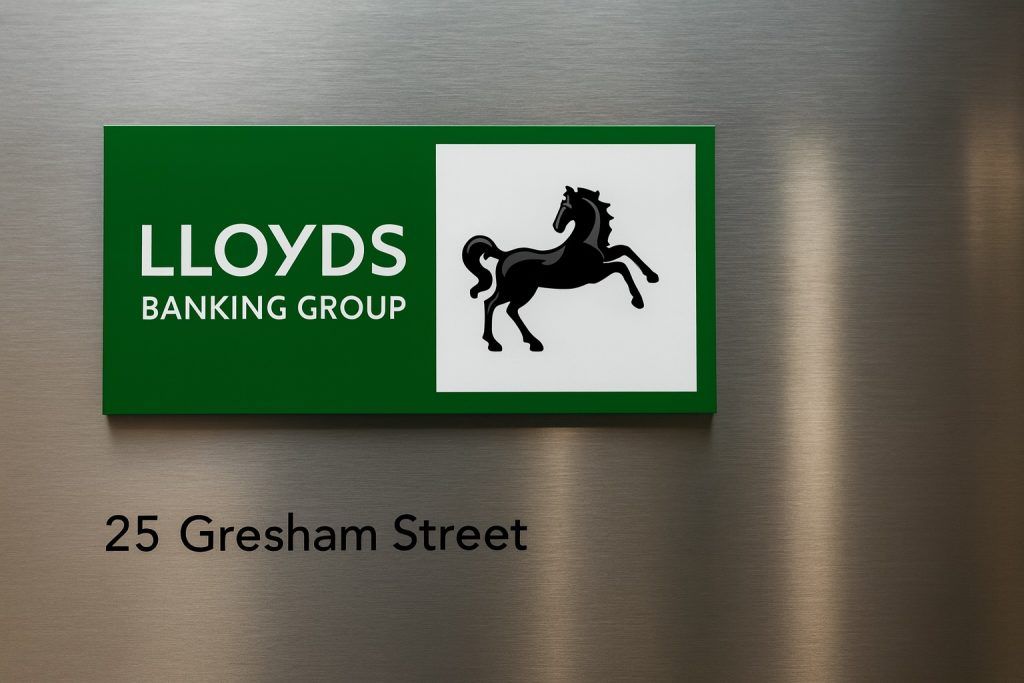- Trading around £11.21: Rolls-Royce Holdings plc (LON: RR) shares are about 1,121 pence (~£11.21) on October 27, 2025, essentially flat from last week’s close [1]. The stock has doubled in 2025, recently hitting an all-time high near 1,196p before a slight pullback [2].
- Record surge in 2025: Even after a brief dip, Rolls-Royce remains up roughly 100% year-to-date, vastly outperforming the broader market [3] [4]. Profit-taking saw the price ease from ~1,135p mid-week to about 1,102p late last week [5] [6], but the FTSE 100 heavyweight is still among 2025’s top gainers.
- Strong earnings & new contracts:Booming demand for jet engines and defense equipment has powered the rally. First-half 2025 underlying profit jumped 50% to £1.7 billion, prompting Rolls-Royce to raise its full-year forecast and sending shares to record highs [7]. Major wins – from a £9 billion nuclear submarine reactor deal [8] to being tapped for Britain’s first small modular reactors (SMRs) with £2.5 billion government backing [9] – have bolstered the company’s outlook.
- Analysts largely bullish: Market sentiment remains optimistic overall. Deutsche Bank recently hiked its price target to 1,220p (“Buy”) [10], and about a dozen analysts now rate Rolls-Royce a “Buy” with no sells – the average 12-month target of ~1,193p implies further upside [11]. However, valuation looks stretched (~40× forward earnings) [12], and some experts warn of near-term “turbulence”. One technical analyst even predicts a dip toward 1,000p in the short term before the next climb [13] [14].
- Turnaround and payouts: CEO Tufan Erginbilgiç says the company’s transformation “is delivering,” with “substantial growth prospects beyond the mid-term” [15]. Under his leadership, Rolls-Royce reinstated dividends (a 6p interim payout) and launched a £1 billion share buyback in 2025 [16] – strong signals of management’s confidence after years of restructuring.
- Market and sector context: Rolls-Royce’s surge has far outpaced a modestly rising FTSE 100 [17] and lifted the index to record territory earlier this year. The stock’s climb – alongside strength in defense peers amid geopolitical tensions – helped make Rolls-Royce one of the five most valuable companies in the index by market cap [18]. Aerospace and defense stocks broadly have benefited from rebounding air travel and higher military spending, though global economic headwinds and conflicts (from inflation to war risks) keep investors watchful [19] [20].
- Forecasts and next moves: Looking ahead, traders are eyeing Rolls-Royce’s trading update due in November for clues to whether new orders and improving profit margins can sustain the momentum [21]. In the near term, some consolidation is expected – the shares have risen very fast – and caution is in the air. Long-term, forecasts remain upbeat: a recent model by TIKR projected Rolls-Royce could reach £12.85 by 2027 (about +17% from today) as its turnaround and market recovery continue [22]. For now, this storied British engineer sits steady around £11, with investors debating if it’s gearing up for another ascent or cooling its jets after an epic 2025 flight.
Rolls-Royce Stock Steadies After Record Surge
Rolls-Royce’s stock is holding steady around £11 per share as of Monday, Oct. 27, after an explosive run this year. In morning trading the share price hovered at approximately 1,121 pence on the London Stock Exchange [23]. That’s virtually unchanged from last week, suggesting the market is catching its breath. Just weeks earlier, Rolls-Royce hit a year-to-date peak of about 1,196p – an all-time high for the company – before easing back slightly [24]. Even with this minor retreat, the stock has doubled in 2025, a remarkable feat for a FTSE 100 blue-chip.
Recent price action: After peaking above the £11 mark, shares saw a mild pullback as some investors locked in profits. Last Wednesday Rolls-Royce traded around 1,135p, only a few points shy of its 2025 high of ~1,192p [25]. By Thursday, it slipped about 2.8% to roughly 1,102.5p intraday [26] – a dip attributed to profit-taking rather than negative news. The stock then stabilized on Friday, closing the week in the low £11 range. This cool-down barely dents Rolls-Royce’s stellar year: the shares are still up roughly 100% year-to-date, making it one of the top performers on the FTSE 100 index [27]. (By comparison, the FTSE 100 is only up modestly in 2025, with a single-digit percentage gain [28].)
Market watchers note that such a breather is healthy after a massive rally. “It is common for a stock to retreat before hitting key resistance,” one analyst observed, noting Rolls-Royce shares encountered chart resistance around £12 and then pulled back [29]. In fact, technical indicators showed a bearish divergence after the September highs, indicating the stock was due for a short-term cooling [30]. The slight decline in late October is seen as a natural pause in an otherwise powerful uptrend.
Rally Fueled by Earnings Jump and Big Contracts
The fundamental story behind Rolls-Royce’s 2025 surge is one of strong earnings and new business wins. The company – known for making jet engines and power systems – has enjoyed booming demand as both global aviation and defense sectors rebound. In the first half of 2025, Rolls-Royce’s underlying operating profit soared 50% to £1.7 billion [31]. This robust result handily beat expectations and prompted management to upgrade its full-year outlook, forecasting higher profit and cash flow for 2025 [32]. The news in July sent Rolls-Royce shares jumping over 11% in a day to record highs, underlining investor enthusiasm [33].
“Transformation [is] delivering”: CEO Tufan Erginbilgiç – who took the helm in 2023 – has been executing an aggressive turnaround plan. His initiatives to cut costs and improve efficiency are bearing fruit, as evidenced by rising margins and cash generation. “We are expanding the earnings and cash potential of Rolls-Royce despite challenges,” Erginbilgiç told reporters after the latest results [34]. He emphasized that the company’s transformation “is delivering” and touted “substantial growth prospects beyond the mid-term” for the business [35]. Those confident words have resonated with investors. Backing them up, Rolls-Royce took the bold step of reinstating its dividend this year (with a 6 pence interim payout) and even launched a £1 billion share buyback program [36]. Both moves signal that management sees the company on a much stronger footing – a striking turnaround for a firm that had suspended shareholder returns during the pandemic crisis.
New contracts and tailwinds: On top of internal improvements, Rolls-Royce has secured major contracts in 2025 that boost its growth prospects. Notably, in January the UK government awarded the company a massive £9 billion contract to design, build, and support nuclear reactors for Britain’s submarine fleet [37]. This eight-year deal (part of the AUKUS defense pact) solidifies Rolls-Royce’s role at the heart of Britain’s defense strategy and comes amid U.S. calls for NATO allies to ramp up military spending [38] [39]. Defence minister John Healey hailed it as “a boost to British jobs [and] business” that underscores how defense can drive economic growth [40]. Investors see such long-term contracts as providing stable, visible revenue for years to come.
Meanwhile, Rolls-Royce’s civil aerospace division is benefiting from a resurgence in air travel. Airlines are flying their wide-body jets more hours as international travel normalizes, which in turn drives up demand for Rolls-Royce’s engine services (the company earns revenue based on hours flown). The company reported that flying hours for its engines have hit record levels this year, helping fuel a 15%+ jump in revenue and much stronger cash flow [41] [42]. With Airbus and Boeing seeing full order books for new aircraft, Rolls-Royce’s pipeline for engine sales and maintenance looks robust.
Another exciting avenue is clean energy technology. Rolls-Royce is expanding into small modular nuclear reactors – a potentially game-changing future energy source. In June, Rolls-Royce SMR (its nuclear venture) won the UK government’s competition to build the country’s first SMRs, beating out several international rivals [43] [44]. The government has pledged £2.5 billion in support for this program [45], which will see Rolls-Royce initially construct three mini nuclear plants to come online in the 2030s. This win positions the company at the forefront of a “golden age of nuclear” energy in Britain, according to officials [46]. While revenues from SMRs are longer-term, the market has cheered the validation of Rolls-Royce’s technology and the potential for a lucrative new business stream beyond aviation.
Additionally, Rolls-Royce is eyeing opportunities in next-generation military aerospace. The company has been mentioned as a partner for developing advanced fighter jet engines – for example, the firm is reportedly in talks to support India’s future combat aircraft engine programs [47]. Such projects could open new markets for Rolls-Royce’s defense segment, leveraging its expertise in high-end turbine technology.
In short, Rolls-Royce’s rally has been underpinned by both cyclical recovery and company-specific wins. The dual boost of strong financial performance (surging profits, higher forecasts) and strategic contract victories (in both defense and energy) has dramatically improved sentiment around the once-troubled engineering giant.
Analyst Views and Price Targets
City analysts have taken notice of Rolls-Royce’s resurgence – and many are positively re-rating the stock. The consensus on the City is bullish, albeit with a dose of caution after the sharp share-price appreciation. According to recent surveys, no major broker recommends selling Rolls-Royce right now [48]. In fact, out of 17 analysts tracked, 12 rate it a “Buy” and 5 rate it “Hold,” with zero “Sell” ratings [49]. The average 12-month price target now stands around 1,192–1,193 pence per share [50]. That target is only about 6% above the current price – suggesting analysts see some remaining upside, but perhaps the easy gains have been made after the stock’s 100% surge this year.
Several banks have upgraded their valuations on Rolls-Royce in light of its improving fortunes. For example, Deutsche Bank in August boosted its target price from 1,000p to 1,220p and reiterated a “Buy” rating [51]. UBS also raised its target in late September, reportedly arguing that the turnaround under CEO Erginbilgiç “has legs” – meaning the improvements in efficiency and earnings have further to run [52]. Berenberg Bank, which had been bearish in the past, dramatically revised its stance as well: it upgraded Rolls-Royce from a Sell to a Hold and lifted its target from a split-adjusted 240p to 1,080p as the company’s prospects improved [53]. These moves underscore a broader point: skeptics have largely been won over by Rolls-Royce’s progress in restructuring and returning to growth.
That said, analysts are not uniformly euphoric – there are notes of caution. One concern is valuation. After the stock’s meteoric rise, Rolls-Royce trades at roughly 40 times forward earnings, which is rich for an industrial engineering firm [54]. (By comparison, rival General Electric’s aerospace division or other defense stocks often trade at lower multiples.) Some analysts worry that the current price already reflects a lot of the good news. “The valuation is now baking in a full recovery and then some,” one commentator noted [55], suggesting there may be limited room for error. If growth were to slow or hiccups emerge (for instance, delays in engine deliveries or cost inflation), the stock could be vulnerable to a correction.
Indeed, a few observers advocate near-term caution. Technical analyst Crispus Nyaga at Invezz, for example, believes Rolls-Royce’s chart is flashing warning signs after its huge rally. He suggests the share price is likely to “plunge to the psychological level at 1,000p” in the short term before resuming any uptrend [56]. That would be roughly a 10% fall from current levels – not drastic in the context of Rolls’ big two-year gains (the stock is up about 1,400% from its pandemic lows), but enough to give new investors pause. Nyaga and others point out that the stock’s relative strength index (RSI) and moving averages showed it in overbought territory in recent weeks, implying a breather is due. In plain terms, Rolls-Royce might be a bit “hot” right now, and buyers could get a better entry point if they wait for a dip.
On the other hand, long-term bulls argue that any short-term volatility doesn’t change the bigger picture. They note that Rolls-Royce’s fundamentals are vastly improved: a growing order backlog, rising cash flows, and new business lines in the pipeline. Some point to insider confidence as well – company management has been buying shares or increasing their stakes, aligning with shareholders’ interests (insider purchases often signal that those who know the business best expect the price to rise). While recent insider transactions have been relatively small [57], the reinstatement of dividends and initiation of buybacks speak volumes about management’s positive outlook.
In summary, most analysts remain optimistic that Rolls-Royce’s turnaround story has further to go, but they also acknowledge the stock isn’t the screaming bargain it was a year or two ago. The prevailing advice is a mix of confidence in the company’s trajectory and caution about the stock’s rapid climb. As one Motley Fool UK commentary quipped, “there could still be enormous value left in the stock [58],” but after a 100% jump in less than 10 months, investors should stay tuned to upcoming updates to justify the next leg up.
Broader Market Context: Sector Tailwinds and Risks
Rolls-Royce’s share price moves are occurring against a backdrop of both supportive sector trends and wider market uncertainties. On the sector front, the aerospace and defense industry is enjoying significant tailwinds in 2025. Global air travel has roared back toward pre-pandemic levels, leading airlines to restore routes and even place new aircraft orders – benefiting engine makers like Rolls-Royce. At the same time, heightened geopolitical tensions have spurred governments to boost defense budgets, creating more demand for military engines and power systems.
In fact, geopolitics have directly bolstered Rolls-Royce’s business. The ongoing war in Ukraine and other global flashpoints have underscored the need for strong defense capabilities among Western allies. The United States has pressured NATO members (including the UK) to spend more on defense, urging targets as high as 5% of GDP [59]. The UK government, under Prime Minister Keir Starmer, has pledged to raise defense spending to 2.5% of GDP in coming years [60]. Such commitments translated into concrete contracts like the submarine reactor deal for Rolls-Royce, and they signal potential for further orders (for example, engine upgrades for fighter jets, or new naval propulsion systems) as militaries modernize. It’s no surprise that defense stocks have been strong across the board – British rival BAE Systems saw its shares climb to record highs in 2025 as well, and U.S. giants like Lockheed Martin and General Electric (GE Aerospace) have outperformed the market amid rising defense outlays.
Meanwhile, civil aviation – the other half of Rolls-Royce’s business – is in an upswing. Airlines worldwide are returning to expansion mode after years of retrenchment. Airbus and Boeing have reported hefty new aircraft orders this year, and both are ramping up production rates. Rolls-Royce, as a key engine supplier for Airbus A350s and A330neo and Boeing 787 Dreamliners, benefits whenever wide-body jets are sold or fly more. Importantly, Rolls earns high-margin aftermarket revenue from maintaining and overhauling engines; the more those planes fly, the more service revenue flows in. In 2025, international travel (especially long-haul routes that use wide-body aircraft) has rebounded strongly, boosting Rolls-Royce’s civil aerospace division. The company noted that engine flying hours were up sharply, approaching or exceeding 2019 levels [61]. This has helped drive the cash flow improvements that Rolls is now using to pay dividends and buy back shares.
From a market standpoint, Rolls-Royce’s stellar ascent has had an outsized impact on the UK stock market’s performance this year. With its market capitalization swelling to around £95–100 billion (roughly $120+ billion), Rolls-Royce is now one of the top five companies in the FTSE 100 by value [62]. Its share price doubling contributed significantly to the FTSE 100 index reaching record highs during mid-2025 [63]. (The index’s heavy weighting in energy and financial stocks had previously limited its gains, so Rolls’ climb was a welcome boost to the benchmark.) As of late October, the FTSE 100 has pulled back slightly from peaks, reflecting global market jitters, but remains up a few percent year-to-date – a far cry from Rolls’s 100% gain, but still a solid showing aided by Rolls and other strong performers.
Risks and headwinds: Investors are mindful that macroeconomic and geopolitical conditions can change quickly. One overhang is the direction of interest rates and inflation. Central banks have tightened monetary policy in 2025 to combat inflation, leading to higher bond yields. Higher interest rates can pressure equities, especially highly valued stocks, as future earnings look slightly less attractive when discounted back. Rolls-Royce’s high P/E multiple could face scrutiny if bond yields keep climbing or if the economy slows down. Additionally, cost inflation (in wages, materials, energy) is a factor Rolls must manage – though so far it has protected its margins via efficiency gains and pricing power.
Another watch item is the Middle East turmoil. While not directly tied to Rolls-Royce’s core operations, conflict in regions like the Middle East can impact oil prices, travel demand, and defense priorities in complex ways. For instance, a spike in oil prices (as seen in 2025) raises costs for airlines, which could eventually dampen aircraft usage or orders if sustained. On the flip side, geopolitical conflicts often spur short-term defense spending. For now, the net effect hasn’t derailed the aerospace sector’s recovery, but it adds a layer of uncertainty.
Lastly, currency fluctuations play a role. Rolls-Royce earns revenue in U.S. dollars (from many airline and defense contracts) but reports in pounds sterling. The pound’s strength or weakness against the dollar can thus influence reported results. In 2025, the pound has been relatively stable, and Rolls’s global footprint provides a natural hedge, but forex swings are something to monitor, as with any multinational.
In essence, the broader context remains cautiously favorable for Rolls-Royce. Demand drivers in its industries are positive, and the company’s revival aligns well with what the market is rewarding (hard assets, defense and infrastructure, post-COVID travel recovery). However, high expectations are now built into the share price, so the company will need to continue executing well to justify its valuation amid whatever curveballs the global economy throws.
Short-Term Outlook and Long-Term Forecasts
Near-term outlook: In the immediate weeks ahead, the spotlight is on Rolls-Royce’s upcoming trading update in November. Investors will be looking for any new guidance or data on second-half trading – essentially a check-up on whether the strong momentum from H1 is carrying through. Key metrics will include orders (are airlines ordering more engines? are there new service contracts?), profit margins (is the cost-cutting holding up under inflationary pressures?), and cash flow progression (continued debt reduction and funding of the buyback). Given how much the stock has risen, expectations are high. Any hint of a slowdown or cautious tone could spark a pullback in the share price. Conversely, if management surprises with additional good news – say, announcing a new large contract or further raising guidance – it could reignite the rally. As one market analysis noted, investors are “keenly awaiting” the trading update to gauge if Rolls-Royce can keep up the pace or if the recent retreat might deepen into a larger correction [64].
Short-term trading sentiment might remain mixed. Some technical signals are flashing caution, as mentioned earlier. We’ve seen a modest loss of momentum after the record high, and the stock is not in oversold territory yet (the relative strength index is around 42, which is neutral) [65]. This could mean the shares will consolidate around current levels – bouncing between, say, 1,050p and 1,150p – in the absence of a new catalyst. It’s also worth watching the FTSE 100’s mood and global markets. If broader equities rally (or sell off) significantly, Rolls-Royce likely will be carried along given its large cap status. As of Monday, the FTSE 100 was little changed and European markets were muted, suggesting no big external push on the day’s trading.
Short-term forecasts: Many analysts expect Rolls-Royce’s share price to remain in a holding pattern or even pull back slightly in the very near term, simply because the stock has run up so far so fast. As noted, a pullback to around 1,000p (roughly 10% below current) has been cited as a plausible scenario by technical experts [66]. However, this is not a unanimous view – it’s more of a risk scenario if market sentiment sours or if the November update disappoints. Absent any negative surprises, the stock could just as easily grind sideways or gradually drift upward. Short-term traders will be monitoring news flow: any new engine contracts, airline industry data (like aircraft orders or flight traffic stats), and macro news like central bank signals or geopolitical developments. In summary, volatility may tick up around the trading update, but there’s no clear consensus that shares will break sharply one way or the other in the next month – much may depend on the tone Rolls-Royce strikes and the numbers it reports.
Long-term forecasts: Looking further out, the consensus is that Rolls-Royce’s trajectory remains positive, even if the pace of share price appreciation slows from the breakneck rate of the past two years. Equity research firm TIKR recently modeled Rolls-Royce’s financial outlook through 2027, and the results were encouraging: their analysis suggests the stock could reasonably reach about £12.85 per share by the end of 2027 [67]. That would represent roughly a 17% increase from today’s price – a solid, if more modest, return after the huge gains already booked. TIKR’s model assumes Rolls-Royce can sustain around 9% annual revenue growth and about 17% operating profit margins in coming years [68]. Those assumptions reflect continued recovery in civil aviation (driving revenue) and ongoing efficiency improvements (driving margins) that bring Rolls’ profitability closer to industry peers. Under those conditions, they assign a price-to-earnings multiple in the low 30s, which yields the ~£12.85 share price projection [69]. In other words, even if Rolls-Royce’s earnings keep improving, the stock’s valuation might compress slightly from current lofty levels – leading to moderate, but not explosive, price gains in the long term.
Other analysts haven’t put specific 2027 numbers on it, but many see room for continued growth. For instance, Morningstar recently named Rolls-Royce its “Stock of the Week” and discussed whether this FTSE high-flier is “still a Buy” at ~£11 [70]. Their fair value estimate reportedly rose to around £11.20 after the strong first-half results [71], indicating that at the recent peak (~£11.96) the stock might have been a bit overvalued but around £11 it’s in a more reasonable range. The Motley Fool UK and other stock commentators point out that if Rolls-Royce’s turnaround truly sticks – with debt coming down and new ventures (like SMRs) contributing – the company could justify an even higher valuation over time, especially given its strategic importance and competitive position. Some optimistic forecasts even suggest the stock could revisit pre-2014 highs (when adjusted for its rights issue) in the mid-teens of pounds in a few years, though those are at the upper end of expectations.
Crucially, the long-term bull case rests on Rolls-Royce continuing to execute well: delivering engines on time, keeping airlines and military customers satisfied, expanding into new markets like small reactors or electric aviation, and hitting its financial targets (like that £3+ billion operating profit goal). If it can do that, investors see Rolls-Royce as a potentially reliable cash cow in years to come – a far cry from the crisis mode it was in during 2020. The company’s own confidence (signaled by returning cash to shareholders) suggests it believes in sustained success. As CEO Erginbilgiç has stressed, the focus is on “expanding the earnings and cash potential” of Rolls-Royce over the mid- to long-term [72].
Bottom line: Rolls-Royce’s shares are pausing around the £11 mark after a phenomenal run. The consensus of market experts is that the stock is no longer cheap, but the company’s fundamentals are dramatically better than they were a couple of years ago. Short-term, the stock could see some choppiness – a bit of turbulence as it were – especially with a key update on the horizon and a high valuation to justify. Long-term, however, many believe this British manufacturing icon has more runway ahead. With its engines powering airplanes and navies, and new projects on the drawing board, Rolls-Royce is once again a company with the wind at its back. Investors will be watching closely to see if 2025’s gains are just one leg of an extended flight upward, or if the stock will level off as the company transitions from turnaround mode to steady growth. The next few weeks and months should provide important clues, but for now Rolls-Royce’s share price story in 2025 has been one of high-flying success – and it’s a story still unfolding.
Sources: Financial Times, Reuters, Yahoo Finance, TS2 Tech (TechStock²) [73] [74] [75] [76], MarketBeat [77] [78], DirectorsTalk Interviews [79] [80], Invezz/cryptorank [81], TIKR.com [82], et al.
References
1. www.directorstalkinterviews.com, 2. ts2.tech, 3. ts2.tech, 4. ts2.tech, 5. stockinvest.us, 6. www.marketbeat.com, 7. ts2.tech, 8. www.reuters.com, 9. www.ans.org, 10. www.marketbeat.com, 11. www.directorstalkinterviews.com, 12. ts2.tech, 13. ts2.tech, 14. ts2.tech, 15. www.reuters.com, 16. ts2.tech, 17. ts2.tech, 18. ts2.tech, 19. www.reuters.com, 20. ts2.tech, 21. ts2.tech, 22. www.tikr.com, 23. www.directorstalkinterviews.com, 24. ts2.tech, 25. stockinvest.us, 26. www.marketbeat.com, 27. ts2.tech, 28. ts2.tech, 29. ts2.tech, 30. ts2.tech, 31. ts2.tech, 32. ts2.tech, 33. www.reuters.com, 34. www.reuters.com, 35. www.reuters.com, 36. ts2.tech, 37. www.reuters.com, 38. www.reuters.com, 39. www.reuters.com, 40. www.reuters.com, 41. www.tikr.com, 42. www.tikr.com, 43. www.ans.org, 44. www.ans.org, 45. www.ans.org, 46. www.ans.org, 47. ts2.tech, 48. www.directorstalkinterviews.com, 49. www.directorstalkinterviews.com, 50. www.directorstalkinterviews.com, 51. www.marketbeat.com, 52. ts2.tech, 53. www.marketbeat.com, 54. ts2.tech, 55. ts2.tech, 56. ts2.tech, 57. www.marketbeat.com, 58. www.fool.co.uk, 59. www.reuters.com, 60. www.reuters.com, 61. www.tikr.com, 62. ts2.tech, 63. ts2.tech, 64. ts2.tech, 65. www.directorstalkinterviews.com, 66. ts2.tech, 67. www.tikr.com, 68. www.tikr.com, 69. www.tikr.com, 70. ts2.tech, 71. global.morningstar.com, 72. www.reuters.com, 73. ts2.tech, 74. ts2.tech, 75. www.reuters.com, 76. www.ans.org, 77. www.marketbeat.com, 78. www.marketbeat.com, 79. www.directorstalkinterviews.com, 80. www.directorstalkinterviews.com, 81. ts2.tech, 82. www.tikr.com







